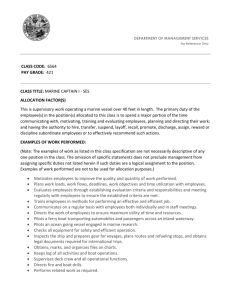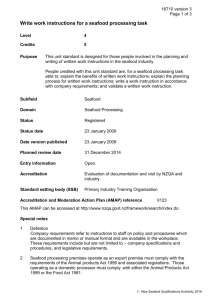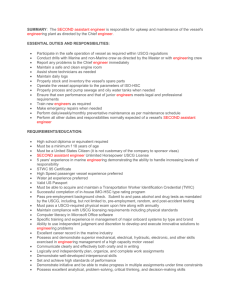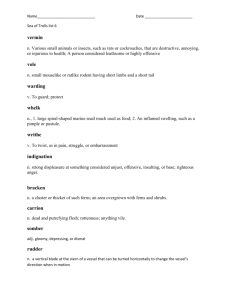19877 Demonstrate knowledge of protection of the marine
advertisement
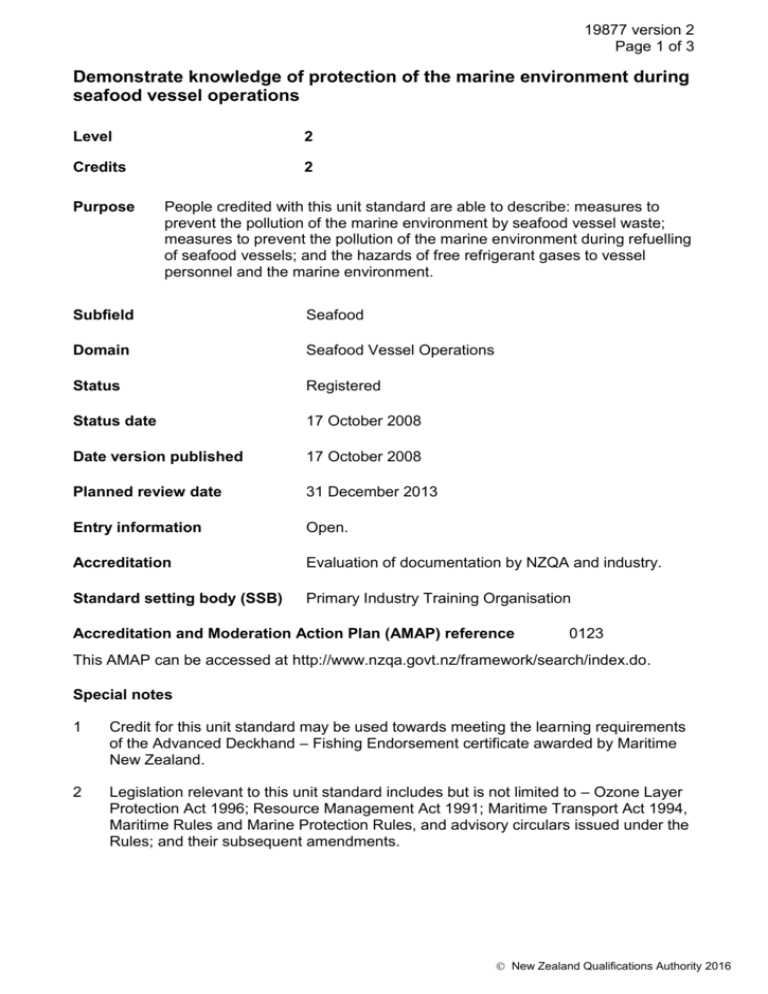
19877 version 2 Page 1 of 3 Demonstrate knowledge of protection of the marine environment during seafood vessel operations Level 2 Credits 2 Purpose People credited with this unit standard are able to describe: measures to prevent the pollution of the marine environment by seafood vessel waste; measures to prevent the pollution of the marine environment during refuelling of seafood vessels; and the hazards of free refrigerant gases to vessel personnel and the marine environment. Subfield Seafood Domain Seafood Vessel Operations Status Registered Status date 17 October 2008 Date version published 17 October 2008 Planned review date 31 December 2013 Entry information Open. Accreditation Evaluation of documentation by NZQA and industry. Standard setting body (SSB) Primary Industry Training Organisation Accreditation and Moderation Action Plan (AMAP) reference 0123 This AMAP can be accessed at http://www.nzqa.govt.nz/framework/search/index.do. Special notes 1 Credit for this unit standard may be used towards meeting the learning requirements of the Advanced Deckhand – Fishing Endorsement certificate awarded by Maritime New Zealand. 2 Legislation relevant to this unit standard includes but is not limited to – Ozone Layer Protection Act 1996; Resource Management Act 1991; Maritime Transport Act 1994, Maritime Rules and Marine Protection Rules, and advisory circulars issued under the Rules; and their subsequent amendments. New Zealand Qualifications Authority 2016 19877 version 2 Page 2 of 3 3 Company requirements refer to instructions to staff on policy and procedures that are communicated in a verbal or written form. These requirements must include legislative requirements and company health and safety procedures and may include but are not limited to, industry codes of practice and standards. 4 Safe Ship Management system means any documented systems on a vessel, which are in place to comply with the NZ Code of Practice for Safe Ship Management (SSM Code) under the Maritime Transport Act 1994, Maritime Rules Part 21, and the Health and Safety in Employment Act 1992. Elements and performance criteria Element 1 Describe measures to prevent the pollution of the marine environment by seafood vessel waste. Range seafood vessel waste includes but is not limited to – solid waste, solvents, cleansing agents, oil, fuel, sewage, contaminated water. Performance criteria 1.1 The disposal of seafood vessel waste is described in accordance with company requirements. 1.2 The description outlines the procedures for the recording and notification of incidents of seafood vessel waste spillage entering waterways in accordance with company requirements. 1.3 The description outlines the procedure for prevention and containment of seafood vessel waste spillages in accordance with company requirements. Element 2 Describe measures to prevent the pollution of the marine environment during refuelling of seafood vessels. Performance criteria 2.1 The description outlines the checks for the operation of the filler system and breathers, and outlines the checks of the equipment to be used for fuel transfer in accordance with the vessel Safe Ship Management system. 2.2 The description outlines the checks for the equipment used for spill clean-up, in accordance with the vessel Safe Ship Management system. 2.3 The description outlines the procedure for the protection of the marine environment in the event of a spill of fuel during refuelling, in accordance with the vessel Safe Ship Management system. New Zealand Qualifications Authority 2016 19877 version 2 Page 3 of 3 Element 3 Describe the hazards of free refrigerant gases to vessel personnel and the marine environment. Range ammonia and one other. Performance criteria 3.1 The description outlines the hazards of free refrigerant gases to the safety of the vessel and vessel personnel in terms of the dangers of asphyxiation, poisoning, and possible explosion. 3.2 The description outlines the long-term effects of CFC and non-CFC refrigerant gases on the marine environment in terms of their effect on the ozone layer. 3.3 The description outlines the emergency procedures in the event of escaping refrigerant gases, in accordance with the vessel Safe Ship Management system, and company requirements. Please note Providers must be accredited by NZQA, or an inter-institutional body with delegated authority for quality assurance, before they can report credits from assessment against unit standards or deliver courses of study leading to that assessment. Industry Training Organisations must be accredited by NZQA before they can register credits from assessment against unit standards. Accredited providers and Industry Training Organisations assessing against unit standards must engage with the moderation system that applies to those standards. Accreditation requirements and an outline of the moderation system that applies to this standard are outlined in the Accreditation and Moderation Action Plan (AMAP). The AMAP also includes useful information about special requirements for organisations wishing to develop education and training programmes, such as minimum qualifications for tutors and assessors, and special resource requirements. Comments on this unit standard Please contact the Primary Industry Training Organisation standards@primaryito.ac.nz if you wish to suggest changes to the content of this unit standard. New Zealand Qualifications Authority 2016




